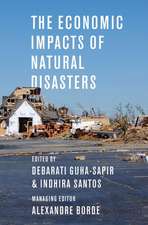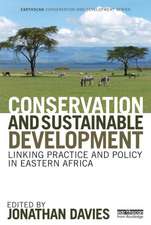Human Casualties in Earthquakes: Progress in Modelling and Mitigation: Advances in Natural and Technological Hazards Research, cartea 29
Editat de Robin Spence, Emily So, Charles Scawthornen Limba Engleză Paperback – 27 feb 2013
| Toate formatele și edițiile | Preț | Express |
|---|---|---|
| Paperback (1) | 642.51 lei 6-8 săpt. | |
| SPRINGER NETHERLANDS – 27 feb 2013 | 642.51 lei 6-8 săpt. | |
| Hardback (1) | 644.95 lei 6-8 săpt. | |
| SPRINGER NETHERLANDS – 5 ian 2011 | 644.95 lei 6-8 săpt. |
Din seria Advances in Natural and Technological Hazards Research
- 18%
 Preț: 977.97 lei
Preț: 977.97 lei - 18%
 Preț: 921.15 lei
Preț: 921.15 lei - 18%
 Preț: 1406.35 lei
Preț: 1406.35 lei - 18%
 Preț: 788.72 lei
Preț: 788.72 lei - 15%
 Preț: 643.84 lei
Preț: 643.84 lei - 18%
 Preț: 955.56 lei
Preț: 955.56 lei - 18%
 Preț: 954.31 lei
Preț: 954.31 lei - 18%
 Preț: 958.56 lei
Preț: 958.56 lei - 18%
 Preț: 937.56 lei
Preț: 937.56 lei - 18%
 Preț: 952.72 lei
Preț: 952.72 lei -
 Preț: 382.18 lei
Preț: 382.18 lei - 15%
 Preț: 647.92 lei
Preț: 647.92 lei - 18%
 Preț: 948.47 lei
Preț: 948.47 lei - 15%
 Preț: 640.06 lei
Preț: 640.06 lei -
 Preț: 407.01 lei
Preț: 407.01 lei - 15%
![Submarine Mass Movements and Their Consequences [With CDROM]](https://i4.books-express.ro/bs/9781402012440/submarine-mass-movements-and-their-consequences-with-cdrom.jpg) Preț: 604.37 lei
Preț: 604.37 lei - 15%
 Preț: 643.48 lei
Preț: 643.48 lei - 15%
 Preț: 648.05 lei
Preț: 648.05 lei - 18%
 Preț: 1236.99 lei
Preț: 1236.99 lei - 18%
 Preț: 947.35 lei
Preț: 947.35 lei - 18%
 Preț: 947.35 lei
Preț: 947.35 lei - 18%
 Preț: 966.15 lei
Preț: 966.15 lei - 15%
 Preț: 642.51 lei
Preț: 642.51 lei - 18%
 Preț: 951.29 lei
Preț: 951.29 lei - 18%
 Preț: 1255.16 lei
Preț: 1255.16 lei - 15%
 Preț: 646.43 lei
Preț: 646.43 lei - 15%
 Preț: 635.96 lei
Preț: 635.96 lei - 18%
 Preț: 1244.08 lei
Preț: 1244.08 lei
Preț: 642.51 lei
Preț vechi: 755.88 lei
-15% Nou
Puncte Express: 964
Preț estimativ în valută:
122.97€ • 127.88$ • 102.90£
122.97€ • 127.88$ • 102.90£
Carte tipărită la comandă
Livrare economică 14-28 martie
Preluare comenzi: 021 569.72.76
Specificații
ISBN-13: 9789400734784
ISBN-10: 9400734786
Pagini: 340
Ilustrații: XVIII, 322 p.
Dimensiuni: 155 x 235 x 18 mm
Greutate: 0.48 kg
Ediția:2011
Editura: SPRINGER NETHERLANDS
Colecția Springer
Seria Advances in Natural and Technological Hazards Research
Locul publicării:Dordrecht, Netherlands
ISBN-10: 9400734786
Pagini: 340
Ilustrații: XVIII, 322 p.
Dimensiuni: 155 x 235 x 18 mm
Greutate: 0.48 kg
Ediția:2011
Editura: SPRINGER NETHERLANDS
Colecția Springer
Seria Advances in Natural and Technological Hazards Research
Locul publicării:Dordrecht, Netherlands
Public țintă
Professional/practitionerCuprins
Preface.- 1. Introduction.- 2. Earthquakes: an Epidemiological Perspective on Patterns and Trends.- 3. Earthquakes Casualty Research and Public Education.- 4. Disaster Casualties – Accounting for Economic Impacts and Diurnal Variation.- 5. A Global Earthquake Building Damage and Casualty Database.- 6. Earthquake Casualty Models within the USGS Prompt Assessment of Global Earthquakes for Response (PAGER) System.- 7. Loss Estimation Module in the Second Generation Software QLARM.- 8. Earthquake Casualties Estimation In Emergency Mode.- 9. Estimating Casualties for the Southern California Shakeout.- 10. Casualty Estimation due to Earthquakes: Injury Structure and Dynamics.- 11. Seismic Vulnerability and Collapse Probability Assessment of Buildings in Greece.- 12. Seismic Casualty Evaluation- the Italian Model an application to the L’Aquila 2009 Event.- 13. Mortality and Morbidity Risk in the L’Aquila, Italy Earthquake of 6 April 2009 and Lessons to be Learned.- 14. Major Factors controlling Earthquake Casualties as revealed via a Diversified Questionnaire Survey in Ojiya City for the Mid-Niigata Earthquake.- 15. Advances in Casualty Modelling facilitated by the USGS Prompt Assessment of Global Earthquakes for Response (PAGER) System.- 16. Challenges in Collating Earthquake Casualty Field Data.- 17. Estimating Human Losses Earthquake Models: A Discussion.- 18. Trends in the Casualty Ratio of Injured to Fatalities in Earthquakes.- 19. Study of Damage to the Human Body caused by Earthquakes: Development of a Mannequin for the Thoracic Compression experiments and Cyber Dummy using Finite Element Method.- 20. A Different View on Human Vulnerability to Earthquakes: lessons from risk perception studies.- Index.
Textul de pe ultima copertă
Assessment of human casualties in earthquakes has become a topic of vital importance for national and urban authorities responsible for emergency provision, for the development of mitigation strategies and for the development of adequate insurance schemes. In the last few years important work has been carried out on a number of recent events (including earthquakes in Kocaeli, Turkey 1999, Niigata Japan, 2004, Sichuan, China 2008 and L'Aquila,Italy 2009). These events have created new and detailed casualty data, which has not until now been properly assembled and evaluated.This book draws the new evidence from recent events together with existing knowledge. It summarises current trends in the understanding of the factors influencing the numbers and types of casualties in earthquakes; it offers methods to incorporate this understanding into the estimation of losses in future events in different parts of the world; it discusses ways in which pre-event mitigation activity and post-event emergency management can reduce the toll of casualties in future events; and it identifies future research needs.Audience:This book will be of interest to scientists and professionals in engineering, geography, emergency management, epidemiology and the insurance industry.
Caracteristici
The only book dealing specifically with human casualties in natural disasters Worldwide authorship of papers Brings together short contributions from many eminent specialists across a variety of disciplines Up to date summary results from recent research both in laboratory and post disaster field investigations Includes supplementary material: sn.pub/extras





